Choosing Your Risk-Reduction Breast Surgeon
Choosing Your Risk-Reduction Breast Surgeon
You are young, fit and healthy, or at least you thought you were, and have just found out that you have tested positive for a BRCA mutation.
What next?
Don’t panic. There is no urgency to do anything right away.
You are still young, fit and healthy, it’s just that you now know that your lifetime risk of developing certain cancers, especially breast and ovarian, is higher than the average person of your age. Focus on the fact that whilst the presence of BRCA mutation increases your lifetime risk, the risk at any point in time, over the next year, two years or five years is very low, especially while you are young.
You need to allow yourself time to absorb the information and the implications.
Do not rush into any hasty decisions.
In Australia, the testing of unaffected individuals, that is, those without cancer, is largely via ”predictive”testing, which is the circumstance in which genetic testing is undertaken to determine if a person has inherited the faulty BRCA gene that has already been identified in one of their close relatives. It is likely therefore that you may be familiar with some of the issues around a positive genetic test result by your relatives’ experiences.
There are two components to your increased risk:
- Risk Assessment
- Risk Management
Risk Assessment
This will usually be carried out by the genetics team when your result is disclosed. Your level of risk depends on the type of mutation and your family history, and importantly is strongly related to your current age. There are tables available which help predict your risk over the next year or ten years based on your age and the type of mutation you have.
Risk Management
There are two components to risk management; Screening and Prevention.This is usually overseen by a breast surgeon. Within the public sector, this may be within a Familial Cancer Centre “High Risk “ Clinic.
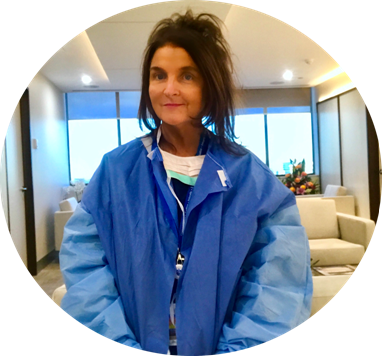
Most health professionals working in this area are sensitive to the complex issues involved when considering preventive surgery. Given however that preventive surgery is relatively uncommon in Australia, some health professionals may seem uncomfortable about this choice, as they may not appreciate the difficulties experienced when faced with the decision.
If you find that you not able to relate to a particular health professional, you should not be afraid to seek out a second opinion. The breast surgeon is usually the first point of contact in the process, andin effect acts as the “gatekeeper” to the rest of the team, including the plastic surgeon, so research is important, and you should preferably aim to see someone who has a special interest in this area.
Also, you should not be afraid to shop around. If the surgeon they are seeing does not offer the procedure they wish to consider, such as nipple-sparing mastectomy for example, you should consider going elsewhere. This is an important and irreversible decision, and you should not proceed with surgery just because you have been seeing a surgeon for many years for screening, if you are not comfortable with the options being offered.
Tips on How to Choose your Risk-Reduction Breast Surgeon
Personal Research
Word of Mouth
Most young women who test positive for a BRCA mutation will have family members affected by breast cancer, and may choose to see their breast surgeons if they come highly recommended.
Online Presence
Just because a surgeon has a fancy website and makes claims of having experience and a special interest in prophylactic surgery, does not always mean it is necessarily true. Not all surgeons have a social media presence, but if they do, this can be a good way to get a general feel for the surgeon. Do they seem to be more interested in posing and socializing than working?
Online Review Sites
Taken with a healthy dose of scepticism, online reviews can be useful. Like Trip Advisor, it can be helpful to get an overall flavour, but do not be overly influenced by a couple of negative reviews, if the majority are overwhelmingly favourable. If for example, you like to be heavily involved in decision making, it may be best to avoid a surgeon whose online reviews indicate that they have a very paternalistic style.
Online Forums
An ideal way to make contact with women in your situation, most of whom are only too willing to offer help and advice.
High Risk Organisations
- Pink Hope is an Australianpreventative health organisation working to ensure that every Australian is empowered to assess and understand their risk of breast and ovarian cancer.Jane O’Brien is a member of the Pink Hope Medical Professional Advisory Committee
www.pinkhope.org.au
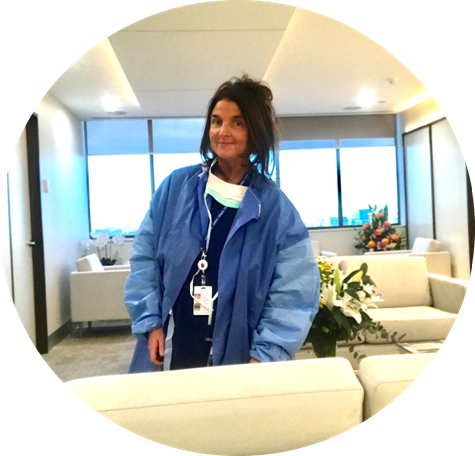
- FORCE (Facing Our Risk of Cancer Empowered) is an American nonprofit dedicated to improving the lives of individuals and families affected by hereditary breast and ovarian cancer.
www.facingourrisk.org/index.php
- Bright Pink is an American non-profit focused on the prevention and early detection of breast and ovarian cancer in young women, which targets women between the ages of 18-45.
www.brightpink.org/high-risk-support/high-risk-resources/
Online Resources
The BasserCenter for BRCAis an American centre for the research, treatment, and prevention of BRCA-related cancers.
- eviQ Online
www.eviq.org.au
- Centre for Genetics Education
www.genetics.edu.au
- Canadian Breast Cancer Foundation
www.support.cbcf.org/get-information/hereditary-breast-ovarian-cancer-hboc/understandingcancer-risks/womens-risk/
- American Cancer Society
www.cancer.org/cancer/cancer-causes/genetics.html
- Centers for Disease Control and Prevention
www.cdc.gov/cancer/breast/young_women/knowbrca.htm
- National Cancer Institute (NCI)
www.cancer.gov/about-cancer/causes-prevention/genetics/brca-fact-sheet
- UptoDate
www.uptodate.com/contents/genetic-testing-for-breast-and-ovarian-cancer-beyond-the-basics
www.uptodate.com/contents/medications-for-the-prevention-of-breast-cancer-beyond-the-basics?topicRef=862&source=see_link
Books
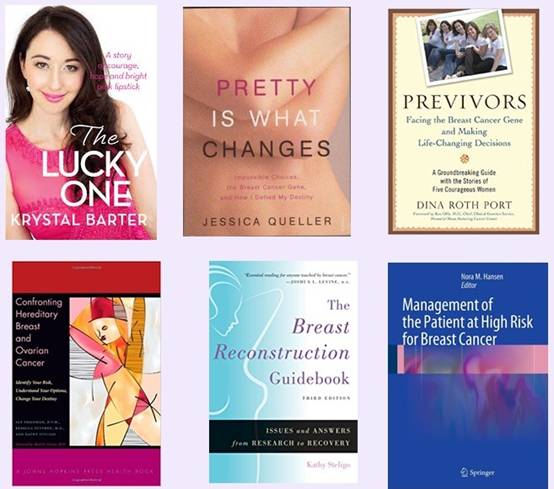
Choosing Your Risk-Reduction Breast Surgeon
The following is a list of things you may wish to consider when choosing your risk-reduction breast surgeon:
- Sex
- Age/Experience
- Training
- Specialisation
- Manner
- Style
- Work environment (public or private sector)
Sex
Many younger women contemplating potential risk-reducing mastectomy may prefer to see a female surgeon. A 1998 Scottish study examining patient preferences for male or female breast surgeons in women with breast symptoms found that:
- 68% – no preference
- 32% – preferred female
- NIL – preferred male
Patients preferring a female surgeon were generally younger.
Age/ Experience
If you are in your early twenties, it is likely that you may have a long-term relationship with a breast surgeon, initially perhaps for MRI screening and perhaps later, risk-reducing surgery. Whilst your mother may have a very good breast surgeon, if they are in their sixties, you may be better served choosing someone younger.
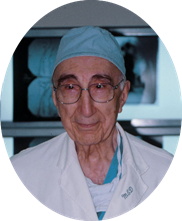 VS
VS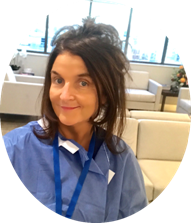
Whilst you may not wish to see someone who is on the brink of retirement, there is no doubt that experience is an important component of surgical expertise, and for your important preventive surgery you may prefer to avoid the younger surgeon who has just completed their surgical training, in favour of someone with greater experience.
Specialist Training
BreastSurgANZ, the Australasian association of breast surgeons, recommends that breast surgeons undergo two years of specialist training in breast surgery after completion of their standard surgical training. Many surgeons who promote themselves widely as specialist breast surgeons have however not completed the required two year breast fellowship. As a rule, when perusing a breast surgeon’s website, if they do not specifically confirm having successfully completed a two year fellowship, outlining where the training was undertaken, and for how long, you can usually safely assume they have not in fact completed the required two years. In my own personal opinion, a surgeon who has demonstrated a high level of commitment to their specialty by spending an extended period of time working in specialist unit(s) overseas, should perhaps be favoured over one who hasn’t. I always think to myself, if a surgeon has cut corners in their training, where else do they cut corners?
Specialisation
Only a small minority of Australian female BRCA carriers undergo risk reducing mastectomy (11% in 2006). Whilst the number of Australian women aged 20-39 who had a mastectomy for reducing their breast cancer risk more than doubled from 99 in 2012/13 to 227 in 2013/14, according to a report by the Australian Institute of Health and Welfare (AIHW), 227 is still a very small number compared to the approximately 18,000 women in Australia diagnosed with breast cancer each year, the vast majority of whom undergo some form of breast surgery as part of their treatment.Therefore only a relatively small number of even specialist breast surgeons perform a significant number of risk reducing mastectomies. As the surgeon exactly how many risk reduction procedures they personally performed in the last 12 months.
Is the surgeon you are considering a general surgeon with a breast interest or a specialist “breast only” surgeon? Do they do emergency general surgery on call, and will you be therefore be competing with general surgical emergencies for their time, or are they a specialist “breast only” surgeon?
Manner
Do you have a specific preference regarding a surgeon’s bedside manner?
Do you like someone chatty or do you prefer a more detached clinical approach?
Style
Does the surgeon look like someone you could relate to?
Do they appear to take care with their own appearance, and does it seem likely that they will prioritise your appearance?
Public or Private Sector?
This is not a final, irreversible decision, and it is possible to switch from one sector to another. If your financial circumstances allow you to choose between the two sectors, you need to weigh up the advantages and disadvantages of each, the main difference being that within the private sector, you are able to choose your own surgeon, which is not always possible in public institutions.
In private:
- You are able to select the surgeon who will perform the actual operation
- There is greater availability of theatre time
- Greater flexibility to easily coordinate operations involving more than one surgeon eg immediate breast reconstruction
- Advance scheduling
- No cancellation of elective procedures
- The entire range of breast implants and mesh products are available for use
- You should confirm in private that the breast surgeon has a breast care nurse in their rooms
- You should also confirm that the breast surgeon works as part of a multidisciplinary team in the hopefully unlikely event that you develop a breast cancer whilst undergoing high risk screening
In public:
- A multidisciplinary risk management clinic may be available, allowing you to see all specialists at the same visit
- Risk-reducing surgery is not categorised as medically urgent, and waiting list times may be long in public (up to two years on occasions) which can be a source of anxiety for some women, who worry about the risk of developing breast cancer whilst on the waiting list.
- There may be significant waiting times when you attend the outpatient clinic for your appointments
Time vs Expense
If you have a very busy job yourself, or are self-employed, time is important. Do online reviews indicate that the surgeon often runs late and appointments consistently run behind time?
What are the approximate out-of-pocket expenses that you are likely to incur in private?
It is possible to join a private health fund after discovering your mutation status, and you are eligible to claim after serving atwelve month waiting period, which is still often quicker than the waiting periodin the public sector. As most women considering risk reducing surgery are younger than the average breast cancer patient, and as such still very much in the workforce age group, this is an option to seriously consider if you are uninsured and would like access to some of the things available only in the private sector, such as some of the newer biological mesh products used in breast reconstruction. Again this option is something to discuss with peers who have gone through the process.
Communication
Are you able to communicate readily with your surgeon?
Does he/she really listen to your concerns?
Does he/she permit email communication of queries?
Good communication channels are particularly important in the case of unforeseen complications.












